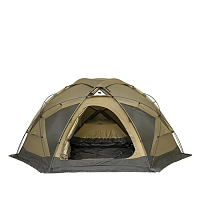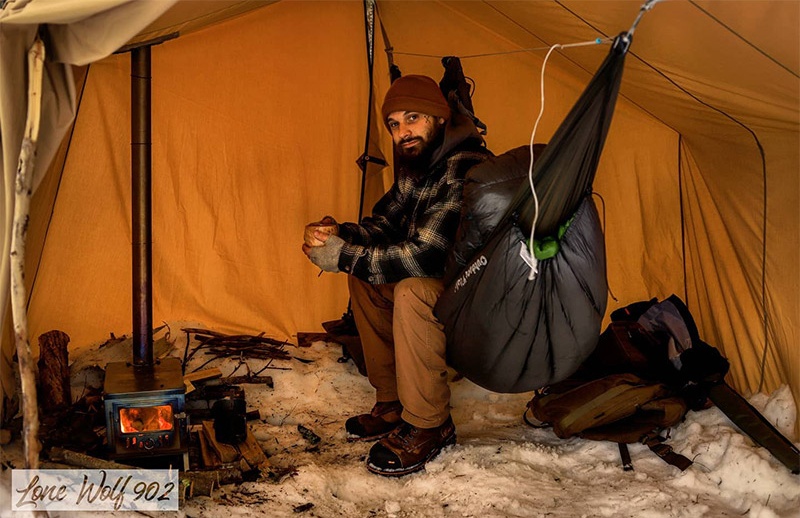Cart
Camping Tent Hammock with Stove Jack for Sale (1)
Camping Tents Designed by Lonewolf902 for Winter Hammock
Lonewolf902 x POMOLY
If you want a tent stove, please check Pomoly tent stove catalog.
If you want a hot tent, please check Pomoly hot tent catalog.
See to the end, I will tell you some useful tips for winter hammock camping!
Winter Hammock Camping Essentials
Camping Tents Hammocks for All Seasons
For hammock camping in cold weather, you need a shelter that provides plenty of warmth! POMOLY's hot tents are highly regarded by camping enthusiasts around the world, and we have proven experience in waterproofing and warming our tents. That's why hammock camping enthusiast Lonewolf902 partnered with POMOLY to design a camping tent hammock. POMOLY hammock tents will meet your expectations!
Hammock Tent Camping Stove
POMOLY also offers a wide range of camping stoves for you to choose from, which are popular all over the world and can be used for heating, cooking and drying wet clothes. POMOLY stoves are a perfect match for camping hammocks!
Your Favorite Hammock
Do's and Don'ts of Winter Hammock Camping
Do's:
1. Use a Wood Stove and Bedding: Use a wood-burning stove in your hammock camping tent to provide hot food and hot water, and line the bottom of your hammock with an insulating blanket to provide warmth and prevent heat loss.2. Choose the Right Hammock Camping Tent: A camping tent designed for hammocks provides enough coverage to protect you and your gear from wind, snow and rain. 3. Stay Dry: Make sure your hammock, tarp and other gear are dry before camping to protect them from wind, snow and precipitation.
3. Keep Dry: Before camping, make sure your hammock, tent and other gear are dry to prevent moisture and hypothermia.
4. Layer up: Dress in layers, including a warm base layer, an insulating layer, and a waterproof outer layer to effectively regulate your body temperature.
5. Use sleeping pads: Place insulated sleeping mats inside the hammock to increase insulation and prevent cold air from seeping in through the bottom.
6. Choose the right campsite: Choose campsites with natural wind barriers such as trees or hills, and avoid low-lying areas where cold air tends to accumulate.
Don'ts:
1. Don't ignore the weather forecast: keep informed of the weather conditions to be well prepared and make wise decisions for camping.2. Avoid wearing cotton clothing: Cotton clothing is highly hygroscopic and poor in keeping warm, so choose fabrics that absorb moisture and dry quickly.
3. Don't neglect insulation: Ensure that you have adequate insulation, including underwear, sleeping pads and a warm sleeping bag, to protect you from the cold.
4. Avoid over-tightening: Avoid over-tightening the hammock as this can create a flat surface, restricting air circulation and reducing warmth.
5. Don't forget safety: Carry necessary safety items such as a first aid kit, navigation tools and emergency communication equipment in case something goes wrong.
6. Avoid wearing wet clothes: Change out of wet clothes immediately and dry them in a wood stove to prevent hypothermia and discomfort.
7. Don't ignore cold-related signs: look out for frostbite, hypothermia or any other cold-related signs and take appropriate measures if necessary.
- Contact Us
-

About Pomoly
Pomoly is a leading camping brand specializing in hot tents and tent stoves. We are camping life explorer, Follow Page / Join Group, let's make camping enjoyful together!
Working Hours
Mon-Fri, 09:00 - 17:00

- Company Info
- NEWS
- About us
- Pomoly Name
- Leave-No-Trace
- Contact Now
- Facebook Group
- YouTube Learning
- Contact Us
- Topic Collections
- Policies & Terms
- Payment Policy
- Shipping Policy
- Return & Refund
- Privacy Policy
- Terms of Use
- Tax Policy
- Website Disclaimer
- Safety Disclaimer
- Warranty Policy
- Promotion Policy
- Pre-order Policy
- INTELLECTUAL PROPERTY RIGHTS
- Dealers Agreement And Terms
- Become Affiliate
- User Center
- Forget Password
- My Orders
- Tracking Order
- My Account
- Register
- Popular Searches
-
Tipi Tents Dome Tents Camping Tent Hammock Stove Camping Camping Pellet Stove Circle 6 Titanium Water TankDome X Locomotive 20 LEO 2 camping tent T-Brick 2.0 T1 2.0 tent stove Dweller wood stove Oroqen 2.0 Chimney Water Tank Lumberjack STOVEHUT Bromance 70 Tipi Pomoly Coupon Baker Oven Stove Titanium elbow Fire Pits Tent Stove titanium Stove Outdoor Pellet Stove
keebon pellet stove









